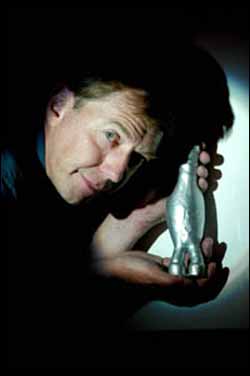Wartime Spitfire Strain Test Monitors Stress On Key Heart Artery – Aortic Aneurysm

Geoff Calvert with the duplicate aneurysm
Researchers at the University of Warwick have found a way of using a test devised in the 1930s, and used to gauge the stress on the superchargers in wartime spitfire fighter planes, to model the stress that surgical procedures would put on an aortic aneurysm. An aortic aneurysm is a dangerous bulge in the body’s largest artery -the aorta. The aorta is a crucial artery as it carries all the blood pumped from the heart.
Photoelasticity is a technique that has been used for decades in industry. It looks at the patterns of coloured light reflected from the surface of an object to gain a detailed understanding of the stresses on that object. In its most modern incarnation photoelectric stress analysis uses high tech light sources and computer analysis to get an even more precise understanding of the stresses involved. However it is all very well mounting a piece of machinery on a test rig to perform these tests but how would one use it to understand the stress on a part of the human body when the human is still using it? Now researchers at the University of Warwick’s Warwick Manufacturing Group working with a surgeon at UCL have found a way to do just that.
Initially surgeons had tried placing mechanical strain gauges on an aortic aneurysm as they manipulated it but found that the gauges themselves placed an unwelcome additional physical strain on the aortic aneurysm. They turned to researchers at the University of Warwick led by Geoff Calvert who had an idea that would combine photoelastic stress analysis with the technology of rapid prototyping to solve the problem. The University of Warwick and UCL researchers took a 3D scan of the patient’s actual aortic aneurysm and used rapid prototyping technology to produce an exact latex duplicate of the aneurysm. They then covered the duplicate with a reflective coating and used photoelastic stress analysis to examine the stress on the model aneurysm as the surgeon manipulated it.
Dr Arindam Chaudhuri a heart surgeon carrying out research at UCL said:
“One of the exciting benefits of this technique is that it will actually allow surgeons to explore a greater range of possible interventions and manipulations of an aneurysm and get a clear picture of the stresses created without the obvious risks that testing less conservative interventions would bring if they were tried out on the actual patient.”
University of Warwick researcher Mr Geoff Calvert is pleased with the success of the work so far. He is now seeking further funding to research materials that could be used in the rapid prototyped aortic aneurysm that would provide an even closer mimic of the mechanical properties of the original aortic aneurysm. He is also looking for support to develop another technique that would stretch the ability of current photoelectric stress analysis equipment to draw on the more limited reflective properties of the original aortic aneurysm which would provide surgeons with a real time monitor of the stress on the aneurysm as they operate.
For more information please contact:
Mr Geoff Calvert, Warwick Manufacturing Group
University of Warwick 024 76575436
Mobile: 0777 3800769 g.c.calvert@warwick.ac.uk
Media Contact
More Information:
http://www.warwick.ac.ukAll latest news from the category: Health and Medicine
This subject area encompasses research and studies in the field of human medicine.
Among the wide-ranging list of topics covered here are anesthesiology, anatomy, surgery, human genetics, hygiene and environmental medicine, internal medicine, neurology, pharmacology, physiology, urology and dental medicine.
Newest articles

Machine learning algorithm reveals long-theorized glass phase in crystal
Scientists have found evidence of an elusive, glassy phase of matter that emerges when a crystal’s perfect internal pattern is disrupted. X-ray technology and machine learning converge to shed light…

Mapping plant functional diversity from space
HKU ecologists revolutionize ecosystem monitoring with novel field-satellite integration. An international team of researchers, led by Professor Jin WU from the School of Biological Sciences at The University of Hong…

Inverters with constant full load capability
…enable an increase in the performance of electric drives. Overheating components significantly limit the performance of drivetrains in electric vehicles. Inverters in particular are subject to a high thermal load,…





















